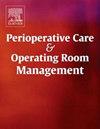Efficacy of perioperative inhalational oxytocin on postoperative pain in lower limb fracture surgeries
IF 1
Q2 Nursing
Perioperative Care and Operating Room Management
Pub Date : 2025-04-29
DOI:10.1016/j.pcorm.2025.100493
引用次数: 0
Abstract
Background
Postoperative pain management in orthopedic surgeries, particularly after lower limb fractures, remains a challenge. Systemic opioids are commonly used but pose risks of addiction and adverse effects. This study investigates the potential of inhalational oxytocin as an adjunct for pain control.
Objective
To evaluate the effectiveness of twice-daily inhalational oxytocin administered three days before and two days after surgery in reducing postoperative opioid consumption.
Methods
A prospective randomized controlled trial was conducted with 36 patients undergoing lower limb fracture surgery. Participants were randomly assigned to two groups:
• Group I (control): Received an inhalational placebo.
• Group II (oxytocin): Received inhalational oxytocin.
Pain scores were assessed using the Visual Analog Scale (VAS), total postoperative morphine consumption, and the time to first analgesic request. Hemodynamic parameters and adverse events were also recorded.
Results
Patients in the oxytocin group demonstrated a delayed first analgesic request (12.89 hours vs. 8.05 hours in the control group, p = 0.001) and significantly lower total morphine consumption (3.22 mg vs. 7.39 mg, p = 0.001). VAS scores were significantly lower at 2, 4, and 6 hours postoperatively in the oxytocin group (p = 0.015, 0.006, 0.001, respectively). No significant differences were observed in mean arterial pressure, heart rate, intraoperative fluid requirements, or adverse events between groups.
Conclusion
Inhalational oxytocin effectively reduced postoperative pain and opioid requirements without affecting hemodynamic stability or causing adverse events. These findings suggest its potential as a safe adjunct in postoperative pain management.
围术期吸入催产素对下肢骨折术后疼痛的影响
骨科手术,特别是下肢骨折后的术后疼痛管理仍然是一个挑战。全身性阿片类药物常用,但有成瘾和不良反应的风险。本研究探讨了吸入性催产素作为疼痛控制辅助手段的潜力。目的评价术前、术后2天每日2次吸入催产素对减少术后阿片类药物消耗的效果。方法对36例下肢骨折手术患者进行前瞻性随机对照试验。参与者被随机分为两组:第一组(对照组):接受吸入性安慰剂。•第二组(催产素):吸入催产素。疼痛评分采用视觉模拟评分法(VAS)、术后吗啡总用量和首次请求镇痛时间进行评估。同时记录血流动力学参数和不良事件。结果催产素组患者首次镇痛请求延迟(12.89 h vs. 8.05 h, p = 0.001),吗啡总用量显著降低(3.22 mg vs. 7.39 mg, p = 0.001)。催产素组术后2、4、6小时VAS评分显著低于对照组(p分别= 0.015、0.006、0.001)。各组间平均动脉压、心率、术中液体需要量或不良事件均无显著差异。结论吸入后叶催产素可有效减少术后疼痛和阿片类药物需求,且不影响血流动力学稳定性或引起不良事件。这些发现提示其作为术后疼痛管理的安全辅助手段的潜力。
本文章由计算机程序翻译,如有差异,请以英文原文为准。
求助全文
约1分钟内获得全文
求助全文
来源期刊

Perioperative Care and Operating Room Management
Nursing-Medical and Surgical Nursing
CiteScore
1.30
自引率
0.00%
发文量
52
审稿时长
56 days
期刊介绍:
The objective of this new online journal is to serve as a multidisciplinary, peer-reviewed source of information related to the administrative, economic, operational, safety, and quality aspects of the ambulatory and in-patient operating room and interventional procedural processes. The journal will provide high-quality information and research findings on operational and system-based approaches to ensure safe, coordinated, and high-value periprocedural care. With the current focus on value in health care it is essential that there is a venue for researchers to publish articles on quality improvement process initiatives, process flow modeling, information management, efficient design, cost improvement, use of novel technologies, and management.
 求助内容:
求助内容: 应助结果提醒方式:
应助结果提醒方式:


